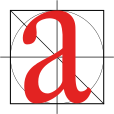Text figures
From Wikipedia, the free encyclopedia
| This article relies largely or entirely upon a single source. Please help improve this article by introducing appropriate citations of additional sources. (August 2008) |

Text figures (also known as non-lining, lowercase, old-style, ranging, or hanging figures or numerals) are numerals typeset with varying heights in a fashion that resembles a typical line of running text, hence the name. This stands in contrast to lining, or titling figures, which are all of consistent height.[1]
In text figures, the shape and positioning of the numerals varies as those of lowercase letters do. In the most common scheme, 0, 1, and 2 are of x-height, having neither ascenders nor descenders; 6 and 8 have ascenders; and 3, 4, 5, 7, and 9 have descenders. Other schemes exist; for example, the types cut by the Didot family of punchcutters and typographers in France between the late 18th and early 19th centuries typically had an ascending 3 to prevent confusion with the cursive form of the lowercase letter z, a form preserved in some later French typefaces. A few other typefaces used different arrangements.
High-quality typesetting prefers text figures in body text: they integrate better with lowercase letters and small capitals, and their greater variety of shape facilitates reading. They help accomplish consistent typographic colour in blocks of text, unlike runs of lining figures which can distract the eye. Lining figures are called for in all-capitals settings (hence the alternate name titling figures), and may work better in tables and spreadsheets.
Although many traditional fonts included a complete set of each kind of numbers, most digital fonts today (except those used by professional printers) include only one or the other. Lining figures remain more common. The few common digital fonts with default text figures include Candara, Constantia and Corbel, Hoefler Text, Georgia, Junicode, and FF Scala. The OpenType edition of Adobe Garamond Pro includes both styles, with the option to choose text figures over the default lining figures.
Contents |
[edit] History
As the name medieval numerals implies, text figures have been in use since the Middle Ages, when Arabic numerals reached twelfth century Europe, where they supplanted Roman numerals.
Lining figures came out of the new middle-class phenomenon of shopkeepers’ hand-lettered signage. They were introduced to European typography in 1788, when Richard Austin cut a new font for type founder John Bell, which included three-quarter height lining figures. They were further developed by nineteenth century type designers, and largely displaced text figures in some contexts, such as newspaper and advertising typography.
The use of text figures suffered further setbacks in the twentieth century, amid attempts to do away with typographic case altogether, and they became rarer still with the advent of phototypesetting.[2] Fine book faces for mechanical typesetting still used text numerals well into the twentieth century, and with digital typography text figures are making a strong comeback.
Text figures are not encoded separately in Unicode, because they are not considered separate characters from lining figures, only a different way of writing the same characters. However, some fonts offer both text and lining figures, using Unicode's Private Use Area for one or the other set; for instance, Adobe's "Pro" fonts use codepoints U+F643 to U+F64C to encode text figures.
[edit] Notes
[edit] References
- Bringhurst, Robert. The Elements of Typographic Style. Vancouver: Hartley & Marks. pp. 46–48. ISBN 0-88179-132-6.
[edit] External links
- Using Numbers in the Proper Case by David Bergsland
|
|||||||||||||||||||||||||||||||



